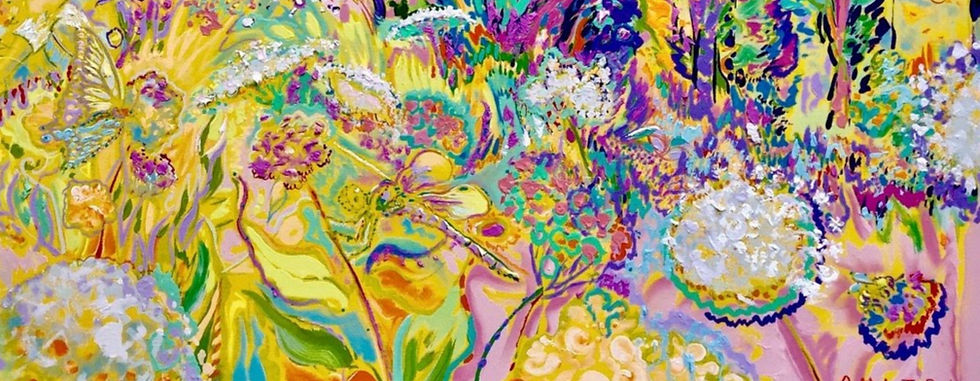7 Composition Types
- Dmitri Wright
- May 10
- 4 min read
Perspective Design Composition
Perspective Design Composition is based on a vanishing point. For example, hold your left hand a few inches away from your left eye and take your right hand and move it away as far as possible. Your left-hand looks more prominent and your right hand appears smaller. Now reverse your hands, holding your right close and your left further away. The discrepancy in size is due to the cone of vision. In other words, similar-sized objects appear to diminish in size as they move further away.
Objects are sized according to their place in space, and their colors are altered to match their placement.
Flat Design Composition
Flat Design Composition is the arrangement of lines and shapes in one visual dimension. This type of composition reduces the picture plane to positive and negative spaces. Both positive and negative spaces are conceived as one flat design; each is as important as the other. For example, view the shape of your hand - your hand is positive, and the space around your hand is negative.
Flat and Perspective together
It is not unusual for impressionists to have flat and perspective designs occurring in the same painting. Perspective elements feature the illusion of representation, and flat design was presented in decorative elements. This interplay of structure and symbol, realism and abstraction, is impressionism at its best for me.
Asymmetrical Composition
Japanese woodblock prints introduced new ideas to the Impressionists about flat design giving a fresh look at asymmetrical composition.
Formal Composition
Formal composition is systemized approach using established rules, thus allowing the artist a framework. The formal composition has a foreground, middle ground, and background. The practice of formal composition is time-honored.
It must be argued that even though the impressionist established their path for creating art, they still learned sound doctrinal elements of the academy canon, which helped them create stimulating and provocative works of art.
The focal point is where the eye focuses on a composition that the artist pre-established on the picture plane. Imagine a stage in a theater in the front of the stage is the foreground, further back still at the curtains is the middle ground, and even further back behind the curtains at the backdrop is the background. Now, if an actor appears standing at the very front of the stage, she or he is in the foreground. At any point of depth from front to rear, the actor is a focal point at the point of interest.
The old master paintings and silent movies would use the same idea of setting their compositions into three distinct layers foreground, middle ground, and background to create the illusion of perspective to place a focal point.
Informal Composition – The Snapshot
Snapshot Composition is similar to informal photography. Here an impressionist seeks to capture what is fleeting as if with a quick impulse. The rapid pace of their cities and urbanscape, with the train taking them to the peaceful villages and countryside, gave the culture a new sense of time and speed.
The Impressionists were ready to take advantage of portable cameras to capture the rapidly changing world around them. Their response to photography: we are now free to explore other ideas about painting since the photos could capture reality; artists were then free to capture the essence. Yet they used the snapshot effect often in painting daily scenes.
Natural Composition
Natural Composition is an intuitive approach of composition it’s a free way of arranging subject matter on the picture plane. Instead of having a planned strategy on how to layout things of interest one simply puts things wear they look or feel best.
Natural Composition bypasses the formal preconceive templates of design. From this perspective, one is free to develop their painting according to internalized sensibility. Generally, artists who are not classically and or formally trained in the academy just formulate their aesthetic on what comes naturally. Often this way is called primitive, childlike, naïve, and humble. From an impressionist perspective, the natural composition could be called post impressionism. Here artists release themselves of formality and seek to compose from their heart, intuitively. They want to be more direct and childlike for greater originality.
Aesthetics of Visual Equilibrium
Asymmetrical compositions are expressionistic formats to convey movement. The asymmetrical composition for the Impressionists was developed through a confluence of new ideas about arranging images on the picture plane in an informal way.
In light of their asymmetrical compositional ideas, Impressionist painters also found the negative space in their paintings interesting to play with as much as the new ideas about light and color.
Keep your compositional design simple
Try not to compose too many ideas into one work. As an alternative, create a series of paintings where you could give proper attention to a variety of ideas.
The under the surface of an impressionist painting has a framework or skeleton of shapes and patterns the artist would make in the early stages of the painting process. The positive and negative shapes expand and contract off a focal point.
Such minimal compositional designs allow one to place much greater emphasis on expressive broken-spaced brushstrokes to create light patterns through color during the painting process.



Comments